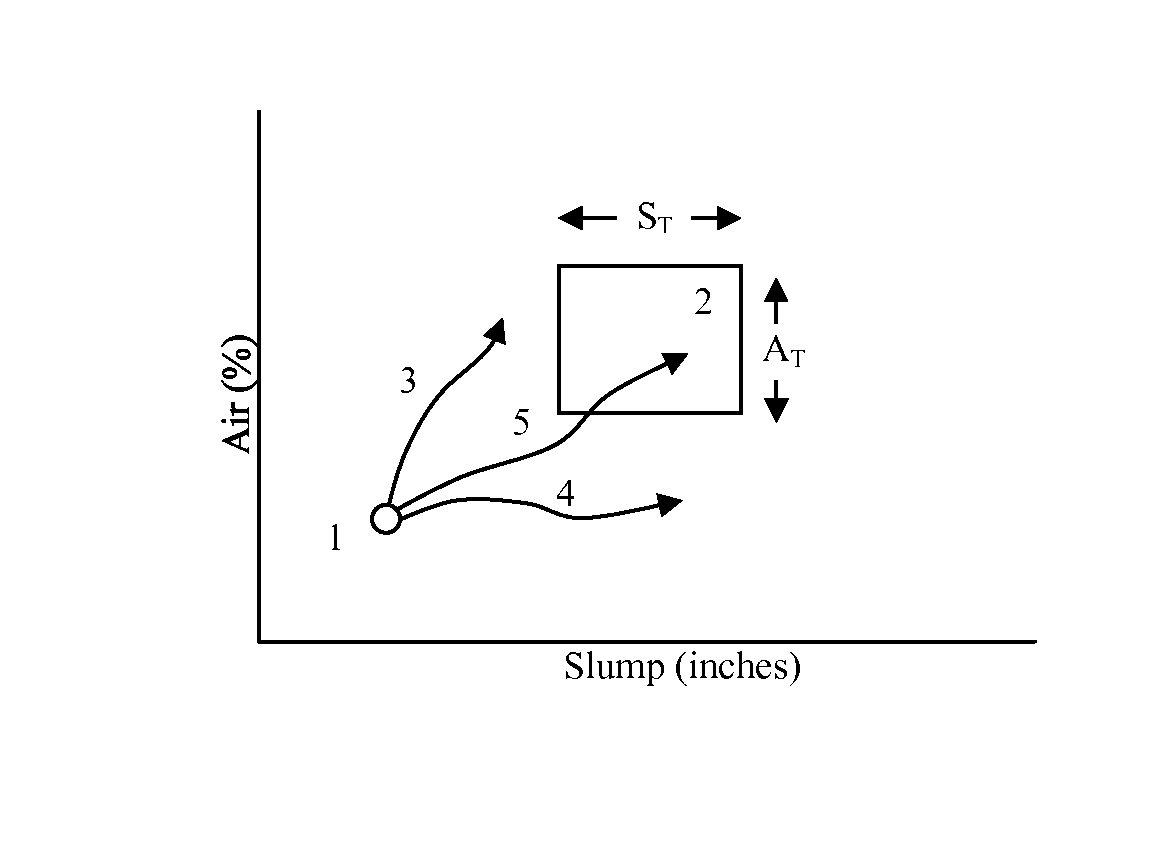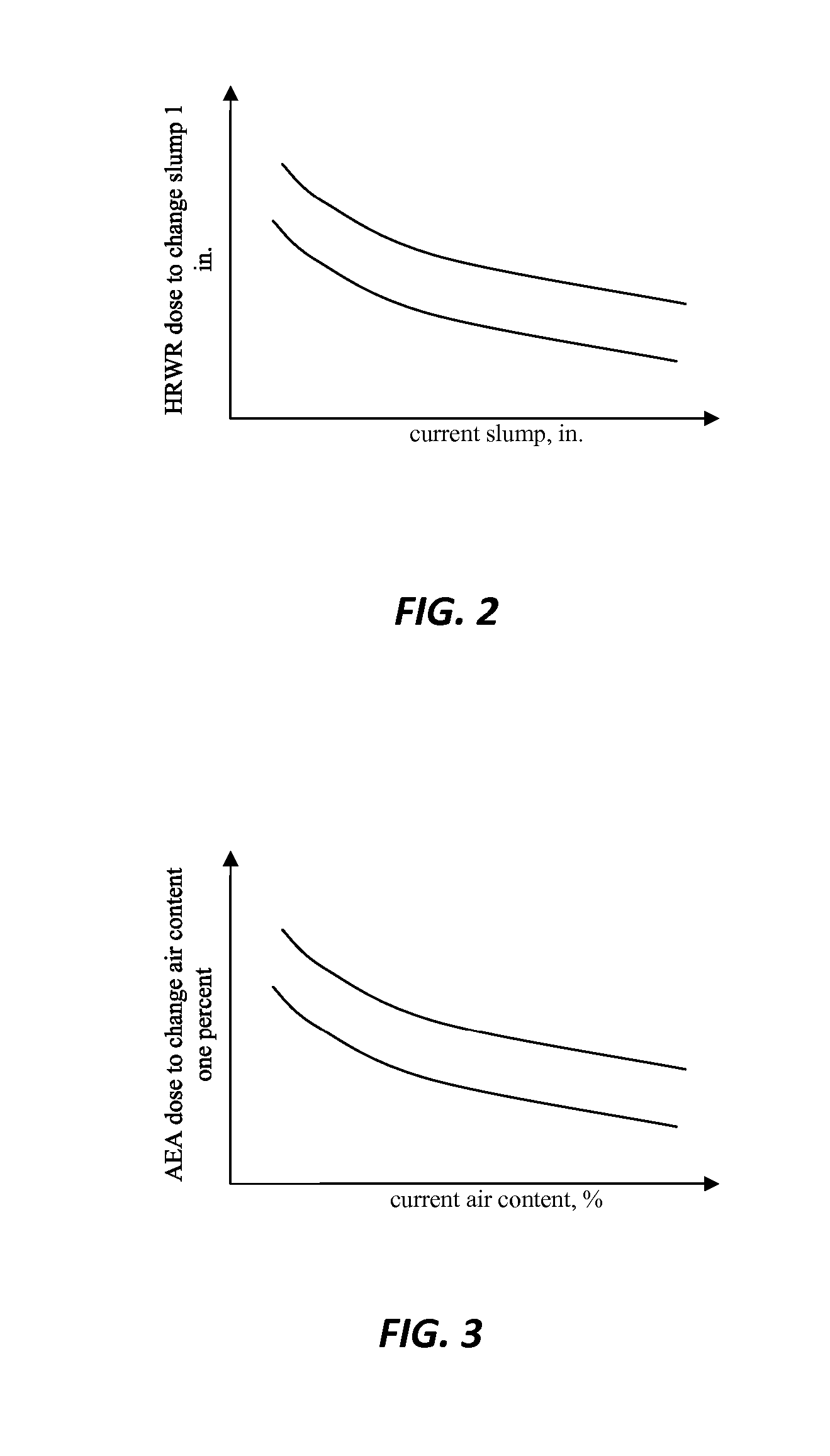Multivariate management of entrained air and rheology in cementitious mixes
a technology of cementitious mixes and entrained air, which is applied in the field of concrete manufacturing, can solve the problems of inability to predict the slump of concrete mixes, inability to accurately and accurately update the information of nominal dose response curves, and inability to integrate or achieve reliability or reliability in practice. , to achieve the effect of high inventiveness and efficient and accurate updating of the information of the nominal dose response curv
- Summary
- Abstract
- Description
- Claims
- Application Information
AI Technical Summary
Benefits of technology
Problems solved by technology
Method used
Image
Examples
example 1
[0126]The following section describes how to generate a dosage response curve or profile for a given admixture, in this case a cement dispersant used for generating a slump profile. A concrete mixture is made in a laboratory mixer without any chemical admixtures added. Slump is measured by removing sample portions of concrete and placing them in a slump cone in accordance with ASTM C143-05. Air content is also measured. When this test is done, the tested mixture is discarded. Immediately thereafter, another concrete mixture having the same concrete mix design is made in the same laboratory mixer, but this time with a chemical admixture (e.g., polycarboxylate polymer cement dispersant). Slump and air content are again measured. When this test was done, the mixture is discarded. A number of further successive samples based on identical mix factors (e.g., temperature, type of cement, amount of air and water, water / cement ratio, etc.) can be made in the laboratory mixer, but each varyin...
example 2
[0130]The NDR profile or curves based on polycarboxylate cement dispersant mentioned in Example 1 above was tested in the field using a concrete mix truck having an automated monitoring and dosing system provided by Verifi LLC of Ohio available under the trade name VERIFI®. This monitoring system measured slump based on hydraulic pressure and mix drum speed. This system can also inject cement dispersant admixture into the mix drum from a small chemical storage tank mounted on the fender. (See also US Patent Publication 2009 / 0037026 of Sostaric et al.). Over a period of months, a variety of concrete mixes were prepared in the concrete mix truck. A nominal dose response profile was obtained, similar to that described above in Example 1, and this was used as the reference or “nominal” reference dose (“NDR”) profile.
[0131]A number of tests were run using the exemplary method of the invention for different concrete mix delivery operations, wherein the NDR was used by the computer process...
example 3
[0135]It is contemplated by the present inventors that NDR profiles can be generated from the curves based on at least four different data correlations, such as the effect of said cement dispersant on rheology (e.g., slump); effect of ACA on entrained air content; effect of said ACA on rheology (e.g., slump); and effect of cement dispersant on entrained air content. Preferably, the NDR profiles are based on a plurality of various delivery operations, involving heterogeneous parameters (e.g., selected from various concrete mix designs, concrete mix ingredient sources, temperatures, degrees of hydration, water / cement ratios, and aggregate amounts. Each of the four sets of data correlations (as illustrated in FIGS. 2-5 would be expected to appear with the same or similar non-intersecting characteristic of the NDR curves in FIG. 7). In preferred embodiments, the data could be transmitted from each individual CPU unit (e.g., in each process control system for the concrete delivery mix tr...
PUM
| Property | Measurement | Unit |
|---|---|---|
| total volume | aaaaa | aaaaa |
| temperature | aaaaa | aaaaa |
| water/cement | aaaaa | aaaaa |
Abstract
Description
Claims
Application Information
 Login to View More
Login to View More - R&D
- Intellectual Property
- Life Sciences
- Materials
- Tech Scout
- Unparalleled Data Quality
- Higher Quality Content
- 60% Fewer Hallucinations
Browse by: Latest US Patents, China's latest patents, Technical Efficacy Thesaurus, Application Domain, Technology Topic, Popular Technical Reports.
© 2025 PatSnap. All rights reserved.Legal|Privacy policy|Modern Slavery Act Transparency Statement|Sitemap|About US| Contact US: help@patsnap.com



